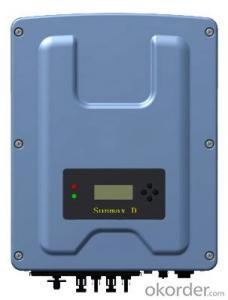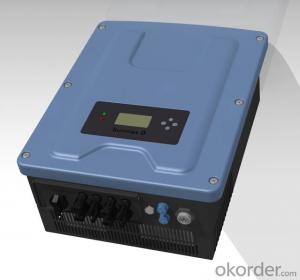On Grid Solar Inverter - Sunmax D 2500/3600/4600 PV Inverter
- Loading Port:
- Shanghai
- Payment Terms:
- TT OR LC
- Min Order Qty:
- 5 watt
- Supply Capability:
- 3000 watt/month
OKorder Service Pledge
OKorder Financial Service
You Might Also Like
Product Details
The Sunmax D 2500/3600/4600 series are applicable to rooftop installation and small scale photovoltaic grid-connected power plants. Their rated output powers are 2.5 kW, 3.6kW, 4.6 kW respectively. This series are transformer-less in design and have a wide range of MPPT voltage. Their maximum conversion efficiency and MPPT tracking accuracy reaches 97.6 % and 99.5 % respectively. The maximum DC voltage reaches 580 V. The series have dual MPPT trackers, providing maximum flexibility for solar plants. The series adopts the latest technology, supports reactive power adjustable and meets the VDE-AR-N 4105 standard.
Characteristics:
Dual MPPT with tracking efficiency over 99.9%
Supporting reactive power adjustable
Unit noise less than 30Db
Current harmonic less than 3%
Design features:
Allows access to third party monitoring system: Solar-log, Solar –man, Taoke, etc.
Equipped with active / inactive way to adjust the design instruction
Single / dual MPPT design
IP65 protection class to meet outdoor installation requirements
Transformer-less design
Units have built-in leakage current monitoring devices
Suspension design, installation is simple
Man-machine interface (LCD) in English, Italian, German languages
Man-machine interface (LCD) regulation parameters can be set making installation easy
Total digital design.
- Q: Can a solar inverter be used with different types of backup power configurations?
- Yes, a solar inverter can be used with different types of backup power configurations. Solar inverters are designed to convert the DC power generated by solar panels into AC power that can be used to power electrical devices and appliances. They can be integrated with various backup power systems such as batteries, generators, or grid connections to provide uninterrupted power supply during periods of low solar generation or power outages. The versatility of solar inverters allows for flexibility in choosing and combining backup power sources based on specific needs and preferences.
- Q: What are the different types of solar inverters?
- There are three main types of solar inverters: string inverters, microinverters, and power optimizers.
- Q: What is the role of a power quality analyzer in a solar inverter?
- A power quality analyzer in a solar inverter is responsible for monitoring and analyzing various electrical parameters such as voltage, current, frequency, harmonics, and power factor. It ensures that the solar inverter is operating efficiently and delivering high-quality power to the grid. By detecting and diagnosing any power quality issues, the analyzer helps in identifying potential problems, optimizing energy production, and maintaining the overall performance and reliability of the solar inverter system.
- Q: Can a solar inverter be used in a commercial solar system?
- Yes, a solar inverter can be used in a commercial solar system. A solar inverter is an essential component of a solar system as it converts the direct current (DC) generated by the solar panels into alternating current (AC) that can be used to power commercial buildings and equipment.
- Q: Three-phase photovoltaic inverter grid, the use of phase-locked loop is what?
- Photovoltaic inverters for grid-connected photovoltaic power generation systems are primarily capable of receiving DC power from photovoltaic arrays and converting them into sine-wave currents of the same frequency and in phase with the access grid for powering the grid or local loads.
- Q: How does a solar inverter prevent islanding?
- A solar inverter prevents islanding by constantly monitoring the grid connection and ensuring there is a stable and continuous power supply. If the grid connection is lost or becomes unstable, the inverter immediately shuts down to prevent the formation of an island, where it would continue to supply power to the disconnected grid. This feature ensures the safety of utility workers and prevents damage to equipment during grid maintenance or emergencies.
- Q: How does a solar inverter handle voltage fluctuations in the grid?
- A solar inverter handles voltage fluctuations in the grid by constantly monitoring the grid voltage and adjusting its own output voltage accordingly. When the grid voltage drops, the inverter increases its output voltage to compensate, and conversely, when the grid voltage rises, the inverter decreases its output voltage. This helps to stabilize the voltage and ensure that the solar system remains connected and operational even during fluctuations in the grid.
- Q: How does the quality of the AC waveform affect the performance of a solar inverter?
- The quality of the AC waveform directly affects the performance of a solar inverter. A clean and stable waveform is essential for efficient and reliable operation of the inverter. Any deviations, distortions, or harmonics in the waveform can lead to increased power losses, reduced conversion efficiency, and potential damage to the inverter. Therefore, a high-quality AC waveform is crucial for optimal performance and maximum power output from a solar inverter.
- Q: Can a solar inverter be used with a solar-powered food dehydrator?
- Yes, a solar inverter can be used with a solar-powered food dehydrator. A solar inverter is responsible for converting the direct current (DC) generated by solar panels into alternating current (AC) that is suitable for powering household appliances. Since a food dehydrator operates on AC power, using a solar inverter allows the solar energy captured by the panels to be utilized effectively in powering the dehydrator.
- Q: Can a solar inverter be used with solar-powered signage systems?
- Yes, a solar inverter can be used with solar-powered signage systems. A solar inverter is responsible for converting the direct current (DC) electricity generated by solar panels into alternating current (AC) electricity which is used to power electrical devices. In the case of solar-powered signage systems, the solar inverter would be an essential component in converting the DC electricity produced by the solar panels into the AC electricity required to operate the signage.
Send your message to us
On Grid Solar Inverter - Sunmax D 2500/3600/4600 PV Inverter
- Loading Port:
- Shanghai
- Payment Terms:
- TT OR LC
- Min Order Qty:
- 5 watt
- Supply Capability:
- 3000 watt/month
OKorder Service Pledge
OKorder Financial Service
Similar products
Hot products
Hot Searches
Related keywords























